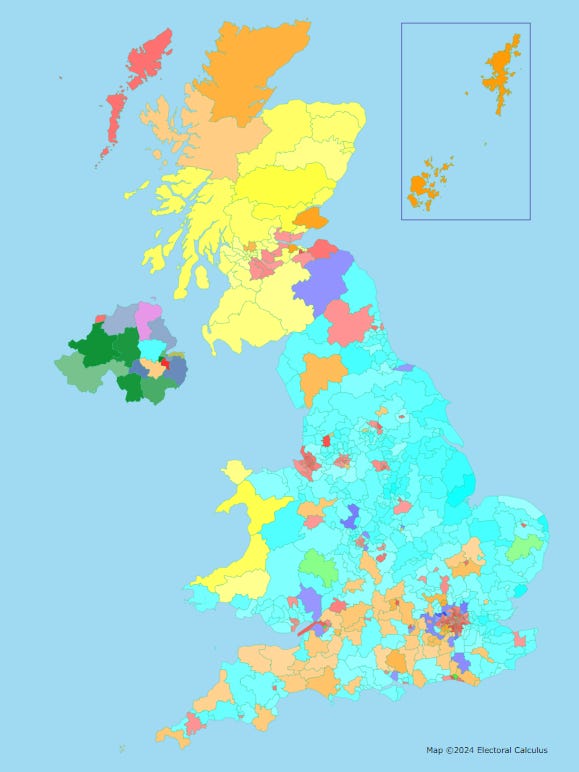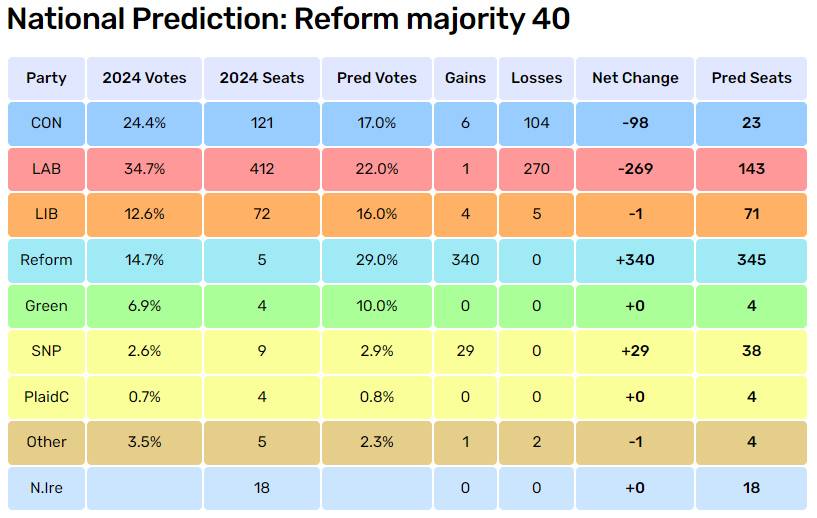Pollster: YouGov
Sample size: 2,187
Fieldwork dates: 5th - 6th May 2025
Source
Key points
A Reform majority, the disappearance of the Red Wall, and the Lib Dem-dominated South.
Reform have secured the over 65s, performing better than both the Conservatives and Labour combined.
Reform’s lead amongst women seems to be set, and comfortably so.
As YouGov themselves point out, the fieldwork for this poll was taken at the beginning of this week, when Reform were experiencing a bounce in the polls because of their barnstorming success in the locals, and warned that this could be a blip. I think the opposite is true: the ‘Shy Reformer’ is being emboldened by the success of the party, and is no longer shy about supporting them.
What would this parliament look like?
A Reform majority emerges, based on the Electoral Calculus predictor:
Parliamentary arithmetic, and First Past the Post, is doing a lot of heavy lifting here. The fact that Reform would seem to win a majority despite having less than 30% of the vote, is dependent on extraordinarily narrow margins and the vote splitting a lot. It would lead to a very Divided Kingdom, though, with the SNP resurging to near total dominance in Scotland.
What would the country look like under a Reform government? At the moment the only concrete policies that have emerged are mass deportations - with Nigel Farage stating the party would create a ‘Minister for Deportations’ in the Home Office - and cuts to the civil service, based on Chairman Zia Yusuf aiming for a 10% reduction in staff via sending in ‘taskforces’ to cut waste.
The only place where the Conservatives are outperforming Reform is in London, which is both surprising and yet completely expected. Expected, because London is usually where the Conservatives lag behind Labour; surprising, because of how narrow the gap is between the Conservatives and Labour. The real worry for the Conservatives is in the South, where they are 8% behind Reform, and 3% behind the Liberal Democrats. If that happens, the South East folds to Reform and the South West to the Liberal Democrats.
The regional map of Britain looks completely different here, as well, especially if we take the long view: compare the 2001 general election map (left) with the potential map if this poll was replicated:


The red wall has completely disappeared, with Labour’s presence in the North - in fact, the entire country - relegated almost entirely to the cities while Reform sweeps into historic Labour strongholds (Nottingham North, Gedling, Leeds West, Rotherham(!), etc.) and routs the Conservatives in their Midlands and Anglian strongholds (Daventry, Norfolk, South Holland, etc.).
The only real anomaly in this poll is the exceptionally low level of support for Reform amongst under 25s. Given the level of support amongst other age groups, this seems odd, as does the sudden jump for the Lib Dems amongst younger voters; nevertheless, it is a stark difference. Where Reform are does exceptionally well is amongst the other voters, performing better amongst over 65s than both the Conservatives and Labour combined.
Finally, and as seems to be a pattern now, Reform are leading amongst women, and by quite a comfortable margin - 10% more than the Conservatives and 8% more than Labour. This is a total reversal of the last few months, where Reform were trailing amongst women. This could be because of Sarah Pochin’s election as the first female Reform MP, though I think that’s a superficial reason. More likely, as I pointed out in my previous poll watch, this could be because of an increasing association in the public’s mind between mass immigration and crime, especially sexual violence, which has formed the crux of the campaign for more data on nationality and crime statistics.
Thank you for reading this short Poll Watch post, in which I look at and discuss the most recent public opinion survey. Please consider subscribing to and sharing this blog and, if you’re feeling particularly generous, subscribing to my paid content -(detailed research and policy proposals).


